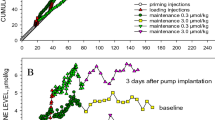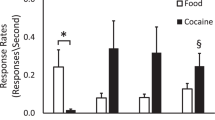Abstract
The ‘dopamine hypothesis’ of schizophrenia states that the illness is due to overactivity of dopamine mechanisms in the brain. This hypothesis is based on two facts: (1) drugs, such as amphetamine, that enhance dopaminergic neurotransmission in the brain, may occasionally provoke a schizophrenic psychosis; and (2) acute administration of neuroleptic drugs, which are used to treat schizophrenia and other psychotic illnesses, causes blockade of brain dopamine receptors and initiates a chain of compensatory events which attempt to overcome such an action. We have previously shown that administration of neuroleptic drugs to rats for up to 18 months produces unexpected effects1,2: after 6 months, all signs of blockade of dopamine receptors in the striatum have disappeared, and thereafter striatal dopamine receptors increase in number and become behaviourally supersensitive to administered dopamine agonists such as apomorphine. We now show that such chronic exposure to neuroleptics completely alters other characteristics of striatal dopamine receptors, and that in the intact animal, these changes are associated with spontaneous overactivity of striatal dopaminergic mechanisms. Unless other dopaminergic brain areas, for example in the mesolimbic or mesocortical regions, react differently from the striatum, the mode of action of neuroleptics, and the dopamine hypothesis of schizophrenia, may have to be reconsidered.
This is a preview of subscription content, access via your institution
Access options
Subscribe to this journal
Receive 51 print issues and online access
$199.00 per year
only $3.90 per issue
Buy this article
- Purchase on Springer Link
- Instant access to full article PDF
Prices may be subject to local taxes which are calculated during checkout
Similar content being viewed by others
References
Clow, A., Jenner, P., Theodorou, A. & Marsden, C. D. Nature 278, 59–61 (1979).
Clow, A., Jenner, P. & Marsden, C. D. Eur. J. Pharmac. 57, 365–375 (1979).
Connor, J. D. J. Physiol., Lond. 208, 691–703 (1970).
Hattiori, T., Singh, V. K., McGeer, E. G. & McGeer, P. L. Brain Res. 102, 164–173 (1976).
Sethy, V. H. & van Woert, M. H. Res. Commun. chem. Path. Pharmac. 8, 13–28 (1974).
Trabucchi, M., Cheney, D., Racagni, G. & Costa, E. Nature 249, 664–666 (1974).
Stadler, H., Lloyd, K. G., Gadea-Ciria, M. & Bartholini, G. Brain Res. 55, 476–480 (1973).
Consolo, S., Ladinsky, H. & Garattini, S. J. Pharm. Pharmac. 26, 275–277 (1974).
Consolo, S., Ladinsky, H. & Bianchi, S. Eur. J. Pharmac. 33, 345–351 (1975).
Consolo, S., Ladinsky, H., Bianchi, S. & Ghezzi, D. Brain Res. 135, 255–263 (1977).
Sherman, K. A., Hanin, I. & Zigmond, J. J. Pharmac. exp. Ther. 206, 677–686 (1978).
Costall, B. & Naylor, R. J. Eur. J. Pharmac. 27, 46–58 (1974).
Chang, H. C. & Gaddum, J. H. J. Physiol., Lond. 79, 255–285 (1933).
Hebb, C. O. & Silver, A. in Neuropathology: Methods and Diagnosis (ed. Tedeschi, C. G.) 665–690 (Little Brown, Boston, 1970).
Feldberg, W. & Hebb, C. J. Physiol., Lond. 106, 8–17 (1947).
Leysen, J. E., Gommeron, E. & Laduron, P. M. Biochem. Pharmac. 27, 307–316 (1978).
Author information
Authors and Affiliations
Rights and permissions
About this article
Cite this article
Murugaiah, K., Theodorou, A., Mann, S. et al. Chronic continuous administration of neuroleptic drugs alters cerebral dopamine receptors and increases spontaneous dopaminergic action in the striatum. Nature 296, 570–572 (1982). https://doi.org/10.1038/296570a0
Received:
Accepted:
Published:
Issue Date:
DOI: https://doi.org/10.1038/296570a0
This article is cited by
-
Conditioning of morphine-induced taste aversion and analgesia
Psychopharmacology (1990)
-
3H-spiperone binding sites in post-mortem brains from schizophrenic patients: Relationship to neuroleptic drug treatment, abnormal movements, and positive symptoms
Journal of Neural Transmission (1989)
-
Effects of long-term administration of antidepressants and neuroleptics on receptors in the central nervous system
Cellular and Molecular Neurobiology (1989)
-
Mesolimbic dopamine function is not altered during continuous chronic treatment of rats with typical or atypical neuroleptic drugs
Journal of Neural Transmission (1985)
-
Differential effects of continuous administration for 1 year of haloperidol or sulpiride on striatal dopamine function in the rat
Psychopharmacology (1984)
Comments
By submitting a comment you agree to abide by our Terms and Community Guidelines. If you find something abusive or that does not comply with our terms or guidelines please flag it as inappropriate.



